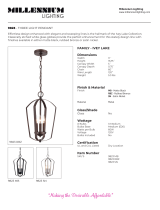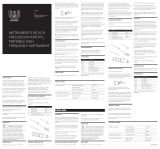Page is loading ...
Page is loading ...
Page is loading ...
Page is loading ...
Page is loading ...
Page is loading ...
Page is loading ...
Page is loading ...
Page is loading ...
Page is loading ...
Page is loading ...
Page is loading ...
Page is loading ...

14 InPro 3100 (i) pH electrode
InPro 3100 (i) pH electrode © 04 / 16 Mettler-Toledo GmbH
52 002 293 Printed in Switzerland
1 Introduction ...................................................................15
2 Safetyinstructions ..........................................................15
3 Product description ......................................................... 15
4 Installationandcommissioning .......................................16
5 Operation .......................................................................16
5.1 CalibrationoftheelectrodeandpHtransmitter ..................16
5.2 Sterilization of electrode ..................................................16
5.3 TemperaturesensorofInPro3100(analogversion) ...........16
6 Maintenance ..................................................................17
7 Trouble-shooting(sluggishresponsetime,insufcientsensiti-
vityetc.) ........................................................................17
8 Disposal
........................................................................17
9 Guarantee ......................................................................17
Contents
en
InPro
3100 (i)
pH Electrode
Instruction Manual
InProandISMareregisteredtrademarks
ofMettler-ToledoGmbHinSwitzerland,theUSA,
theEuropeanUnionandafurthervecountries.
12 mm
0.47"
Connectortype(here:VP)
Bridgeelectrolyte
Silver-iontrapanddiaphgragm
Referenceelectrolyte
Temperaturesensor
Argenthalreferenceelement
Diaphragm
pH sensitive glass
en Instruction Manual

InPro 3100 (i) pH electrode 15
© 04 / 16 Mettler-Toledo GmbH InPro 3100 (i) pH electrode
Printed in Switzerland 52 002 293
1 Introduction
The METTLER TOLEDO InPro 3100(i) pH electrodes are
low-maintenance, autoclavable and pressure-resistant
measuringelectrodeswithagel-typereferenceelectrolyte.
The reference element incorporates a silver-ion trap to
preventsilversuldeprecipitationonthediaphragm.Incase
ofInPro3100,atemperaturesensorisintegrated,mainlyfor
automatictemperaturecompensationpossibilitiesofthepH
signal during calibration and operation.
The InPro 3100(i) electrodes are mainly designed for
the measurement of pH value in biotechnical processes
at moderate pressures (<6bar). It can be used under
industrial fermentation, pilot and laboratory conditions,
and is particularly intended for those processes where
intermediatesterilizationorautoclavingisindispensable.
Pleasereadthroughtheseoperatinginstructionscarefully
beforecommissioning,inordertoensuretrouble-freeuse.
2 Safetyinstructions
The InPro 3100(i) electrodes are intended solely for the
purposedescribedin§1above.Theelectrodeconsistspartly
ofglassandshouldbehandledcarefully.Iftheelectrodeis
tobecleanedorcalibratedusingacidoralkalinesolutions,
safetygoggles and gloves shouldbeworn.Localsafety
regulationsareapplicabletothehandlingoftheelectrode.
Pleasefollowtheguidelinesenclosedforaninstallationin
theEx-zone.
We recommend that you only operate the electrode in
combination with original parts from METTLER TOLEDO.
Operationandmaintenanceshouldbecarriedoutonlyby
trainedpersonnelandstaffwhohavereadandunderstood
theoperatinginstructions.
3 Product description
The inscriptionon each electrode contains thefollowing
information:
METTLER TOLEDO Manufactureroftheelectrode
InPro
®
310XiUD/SG/yyy/zzzTypedesignation;X=membrane
glass;i=ISMDigital;UD=upside
down/SG=ancillaryelectrode/
yyy=rodlengthinmm/zzz=type
oftemperaturesensor
combinationpH Typeofelectrode
pH0…14 pHmeasurementrange
0…80°C/140°C(130°C) Temperaturerangeforoperation/
sterilization(forInPro3100UD)
OrderNo.5200XXXX Ordernumber
SEV14ATEX0168X Identicationandnumber
ofcerticate
IECExSEV14.0025X Identicationandnumber
ofcerticate
IS/I,II,III/1/ABCDEFG/T6 FMapproved
Seeinstructionmanual! Instruction(Observethe
operating instructions)
Inadditioneachelectrodeisallocatedaserialnumberon
theplug-inheadtoenableidenticationandtraceability.
en

16 InPro 3100 (i) pH electrode
InPro 3100 (i) pH electrode © 04 / 16 Mettler-Toledo GmbH
52 002 293 Printed in Switzerland
4 Installationandcommissioning
1. On unpacking, check the electrode for mechanical
damage of the pH sensitive glass and shaft. Report
any damage immediately to your METTLER TOLEDO
supplier.
2. Removethewateringcapandbrieyrinsetheelectrode
withdeionizedwater.Afterrinsing,theelectrodeshould
onlybedabbeddrywithatissue.DonotrubthepH
sensitive glass, since this can lead to electrostatic
chargingandsluggishresponsetimes.
3. CheckthespacebehindthepHsensitiveglassforthe
presenceofanyairbubblesandremovesamebygently
swingingtheelectrodeinaverticalplane.
4. Please refer to the instruction manual of the relative
housinginordertoinstalltheelectrode.
5. Connect the electrode to the pH transmitter, using a
cable with the appropriate connector (VP connector
forInPro3100).Pleaserefertothewiringandterminal
diagramaccompanyingthecable.
6. Intelligent ISM
®
electrodessuchasInPro310Xienable
“Plug and Measure” and extended diagnostics. For
installation, commissioning and operation of the
ISM system please observe the instructions for the
transmitter,moduleandcable.
5 Operation
5.1CalibrationoftheelectrodeandpHtransmitter
FortheInPro3100(i)electrodea2-pointpHcalibrationis
recommended.Beforecalibration,rstremovethewatering
cap.Tospeeduptheresponsetimeoftheelectrodeafter
longtransportandstorageperiods,andbeforecalibration,
diptheelectrodeintobufferpH7,bufferpH4andbufferpH
7again,eachtimeforaboutoneminute.Theelectrodeis
thendippedsuccessivelyintotwodifferentbuffersolutions
withgivenpHreferencevaluesandthetransmittercalibrated
tothesebuffervalues.NormallyyoustartwithbufferpH7
fordeterminingthe0-pointandthenbufferpH4or9for
determiningtheslope.Inthecaseofmicroprocessor-based
transmitters with buffer recognition,the order of the two
chosenbuffer solutionsis irrelevant.Whenever possible,
atemperaturesensor(forInPro3100theintegratedone)
should be connected to the transmitter and “automatic
temperaturemeasurement”selectedthere.Pleasereferto
theinstructionmanualofthetransmitterforfurtherdetails.
5.2Sterilizationofelectrode
TheInPro3100(i)electrodecanbesterilizedeitherthrough
autoclaving (remove red protection cap) or through in-
situ sterilization with steam or superheated fermentation
medium. Sterilization temperatures above 140°Care not
allowed,andexcessivesterilizationtime(forinstancet>30
minat140°C)could notably shorten the life time of the
electrode.Repeatedsterilizationand/orautoclavingofthe
electrodecanleadtoaslightcolorationoftheelectrolyte.
This color change does not effect the functioning of the
electrode.
5.3TemperaturesensorofInPro3100(analogversion)
The integrated Pt100/1000 temperature sensor in the
InPro3100isprimarilyintendedforautomatictemperature
compensationofthepHsignalandnotforanyaccurate
andsafetemperatureindicationorcontroloftheprocess
temperature. If you anyhow want to try this, check that
yourtransmitter has the required temperature indication
accuracyandafree outletforthesignal.Furthermore,a
calibrationofthetemperaturesignalmightbenecessary.
en

InPro 3100 (i) pH electrode 17
© 04 / 16 Mettler-Toledo GmbH InPro 3100 (i) pH electrode
Printed in Switzerland 52 002 293
6 Maintenance
1. Carefully rinse the electrode tip and diaphragm with
deionizedwateraftereachproductioncycle.Underno
circumstancesmustmeasuringsolutionbeallowedto
dryontheseparts!
2. When the electrode is not in operation, store it with
electrode tip and diaphragm well submerged into
9823
/3MKClor9816/Viscolyt™electrolyte.
3. Iftheelectrodeisstoredmountedinitshousing,the
same rule as in 2) above applies, but the storage
electrolytehastobeslightlymodied,with2partsof
buffersolutionpH9.2to10partsofelectrolyte,thisin
ordertoavoidcorrosionofhousingparts.
4. Ifanelectrodeisstoreddryforafewdaysbymistake,
letitsoakinthenormalstorageelectrolyteforseveral
hoursbeforeuse.
5. Occasionallychecktheconnectorforpossibletracesof
moisture.Ifnecessary,cleanwellwithdeionizedwater
oralcohol,andafterwardsdrycarefully.
7 Trouble-shooting(sluggishresponsetime,
insufcientsensitivityetc.)
TheglassmembranecanbereactivatedusingaHFsolution
(orderno.51319053).Theelectrodetip(onlypHsensitive
glasspart)isimmersedintotheHFsolutionforaperiodof
about5minutes,isthenimmediatelyandthoroughlyrinsed
withdeionizedwaterandthereafterstoredinbuffersolution
pH4(seepoint6above)uptothediaphragmfor12hours.
Po s siblep rote inpre c ipita t ionandblocka geoft h e diaphra g m
canbetreatedwithourspecialelectrodecleaner(orderno.
51340068).However,useofthediaphragmcleaner(order
no.51340070)isnormallynotnecessaryforthiselectrode
type,asthebuilt-insilver-iontrappreventstheformationof
silversuldecontamination.
Also,checktheconnectorforpossibletracesofmoisture.If
necessary,cleanwellusingdeionizedwateroralcohol,and
afterwardsdrycarefully.
8 Disposal
If no relative ofcial regulations are in force, used or
defectiveInPro3100(i)electrodesandthepackagingcan
bedisposedofasordinaryhouseholdwaste.
9 Guarantee
Onmanufacturingdefects,12monthsafterdelivery.
en
Page is loading ...
Page is loading ...
Page is loading ...
Page is loading ...
Page is loading ...
Page is loading ...
Page is loading ...
Page is loading ...
Page is loading ...
Page is loading ...
Page is loading ...
Page is loading ...
Page is loading ...
Page is loading ...
Page is loading ...
Page is loading ...
Page is loading ...
Page is loading ...
Page is loading ...
Page is loading ...
Page is loading ...
Page is loading ...
Page is loading ...
Page is loading ...
Page is loading ...
Page is loading ...
Page is loading ...
Page is loading ...
Page is loading ...
Page is loading ...
Page is loading ...
Page is loading ...
Page is loading ...
Page is loading ...
Page is loading ...
Page is loading ...
Page is loading ...
Page is loading ...
Page is loading ...
Page is loading ...
Page is loading ...
Page is loading ...
Page is loading ...
Page is loading ...
Page is loading ...
Page is loading ...
Page is loading ...
Page is loading ...
Page is loading ...
Page is loading ...
Page is loading ...
Page is loading ...
Page is loading ...
Page is loading ...
Page is loading ...
Page is loading ...

74 InPro 3100 (i) pH electrode
InPro 3100 (i) pH electrode © 04 / 16 Mettler-Toledo GmbH
52 002 293 Printed in Switzerland
–
Notes
Page is loading ...

Brazil Mettler-ToledoInd.eCom.Ltda.
AvenidaTamboré,418–Tamboré,
BR-06460-000Barueri/SP,Brazil
Phone+551141667400
e-mailmettler@mettler.com.br;service@mettler.com.br
France Mettler-ToledoAnalyseIndustrielleS.A.S.
30,Bld.deDouaumont,FR-75017Paris,France
Phone+33147370600
e-mailmtpro-f@mt.com
Germany Mettler-ToledoGmbH
Prozeßanalytik,Ockerweg3,DE-35396Gießen
Phone+49641507-444
e-mailprozess@mt.com
Switzerland Mettler-Toledo(Schweiz)GmbH
ImLangacher,CH-8606Greifensee
Phone+41449444760
e-mailProSupport.ch@mt.com
United States METTLER TOLEDO
ProcessAnalytics
900MiddlesexTurnpike,Bld.8,Billerica,MA01821,USA
Phone+17813018800
Freephone+18003528763(onlyUSA)
e-mailmtprous@mt.com
FormoreaddressesofMETTLERTOLEDOMarketOrganizationspleasegoto:
www.mt.com/pro-MOs
Mettler-ToledoGmbH,ProcessAnalytics,ImHackacker15,CH-8902Urdorf
Phone+41447296211,Fax+41447296636
Subjecttotechnicalchanges
04/2016©Mettler-ToledoGmbH
PrintedinSwitzerland.52002293
www.mt.com/pro
Addresses|Impressum
/

